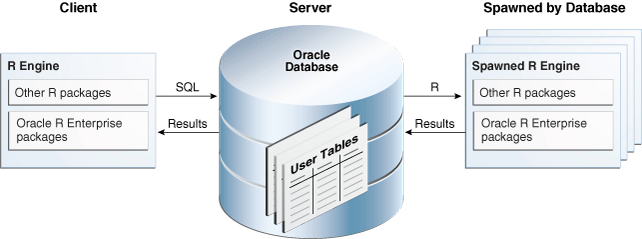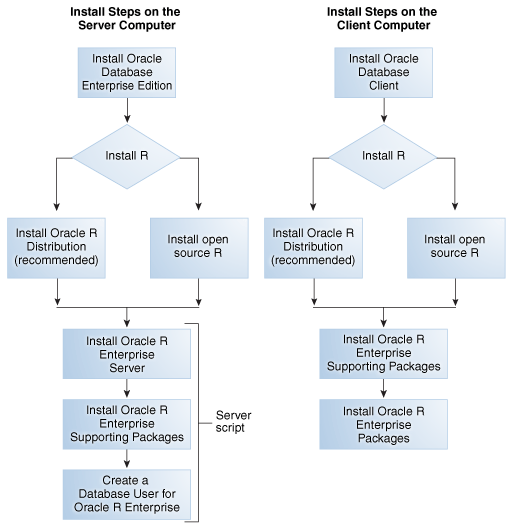1 Overview of Oracle R Enterprise Installation
This chapter introduces the Oracle R Enterprise installation process. This chapter contains the following topics:
1.1 Oracle R Enterprise Architecture
Oracle R Enterprise has a client/server architecture based on Oracle Database and Oracle Client. R engines run on the server computer and on each client computer.
-
SQL Transparency
Oracle R Enterprise packages on the client support SQL transparency, which enables Oracle tables to appear "transparently" as native R objects. With SQL transparency, data analysts can use R to explore, cleanse, and transform data without having to know SQL.
-
Embedded R Execution
Oracle R Enterprise packages, libraries, and R and SQL APIs on the server support the execution of R commands within SQL queries and PL/SQL statements. Embedded R is executed in spawned R engines that can run in parallel. With embedded R, you can execute R algorithms on very large data sets, and you can use database facilities like
DBMS_SCHEDULERto schedule the execution of user-defined R functions for lights out processing.
Figure 1-1 illustrates the client/server architecture of Oracle R Enterprise.
Figure 1-1 client/server Architecture of Oracle R Enterprise

Description of "Figure 1-1 client/server Architecture of Oracle R Enterprise"
1.2 Client and Server Components of Oracle R Enterprise
1.3 Oracle R Enterprise Installation Steps
The Oracle R Enterprise client and server installation steps are illustrated in Figure 1-2.
Figure 1-2 Oracle R Enterprise Client and Server Installation Steps

Description of "Figure 1-2 Oracle R Enterprise Client and Server Installation Steps"
The Oracle R Enterprise Server installation script can install the supporting packages and create a database user along with the installation of Oracle R Enterprise Server. See Chapter 4 for details.
Note:
If you intend to use both client and server components of Oracle R Enterprise on the computer that is hosting Oracle Database, then you do not need to perform a separate client installation. A local installation of Oracle Database Client is automatically included in the installation of Oracle Database.1.4 Oracle R Enterprise System Requirements
Oracle R Enterprise runs on 64-bit platforms only. Both client and server components are supported on each of the platforms described in Table 1-1.
Table 1-1 Oracle R Enterprise Platform Requirements
| Operating System | Hardware Platform | Description |
|---|---|---|
|
Intel and AMD |
Oracle Linux may be running on Oracle Exadata Database Machine. |
|
|
Intel and SPARC |
Oracle Solaris may be running on Oracle Exadata Database Machine. |
|
|
IBM |
||
|
Intel |
See Section 1.4.1, "Verifying 64-Bit Architecture on Microsoft Windows". |
Table 1-2 shows the supported configurations of Oracle R Enterprise server components. Oracle recommends that you use Oracle R Distribution, Oracle's free distribution of R, with Oracle R Enterprise. You should install Oracle R Distribution before installing Oracle R Enterprise.
Table 1-2 Oracle R Enterprise Server Support Matrix
| Oracle R Enterprise | Open source R or Oracle R Distribution | Oracle Database (see Note) |
|---|---|---|
|
1.0 |
2.13.2 |
11.2.0.3, 11.2.0.4, 12.1.0.1 |
|
1.1 |
2.13.2 |
11.2.0.3, 11.2.0.4, 12.1.0.1 |
|
1.2 |
2.15.1 |
11.2.0.3, 11.2.0.4, 12.1.0.1 |
|
1.3 |
2.15.1 |
11.2.0.3, 11.2.0.4, 12.1.0.1 |
|
1.3.1 |
2.15.1, 2.15.2, 2.15.3 |
11.2.0.3, 11.2.0.4, 12.1.0.1 |
|
1.4 |
3.0.1, 3.1.1 |
11.2.0.3, 11.2.0.4, 12.1.0.1 |
|
1.4.1 |
3.0.1, 3.1.1 |
11.2.0.3, 11.2.0.4, 12.1.0.1 |
Note:
Oracle Database versions 11.2.0.1 and 11.2.0.2 are supported on Linux if patched. For instructions, see Section 2.2, "Patching an 11.2.0.1 or 11.2.0.2 Database on Linux".On other platforms, Oracle Database 11.2.0.3, 11.2.0.4, or 12.1 is required.
See Also:
-
Oracle R Enterprise Release Notes for the latest platform requirements and the latest versions of R that are supported with Oracle R Enterprise.
1.4.1 Verifying 64-Bit Architecture on Microsoft Windows
Oracle R Enterprise only runs on 64-bit operating systems. You can determine if your Windows system is 64-bit by following these steps:
-
Windows 7 or Windows Vista:
-
From Windows Control Panel, choose System.
-
Verify that System type is 64-bit Operating System.
-
-
Windows XP:
-
From the Start menu, choose My Computer.
-
Click Properties.
-
On the System tab, verify that the system is x64 Edition.
-